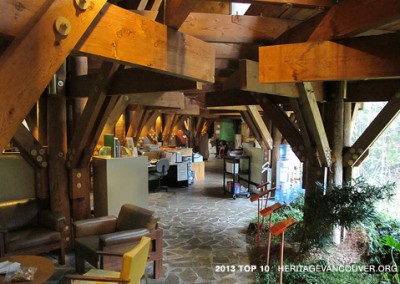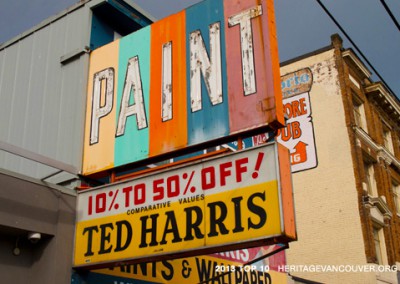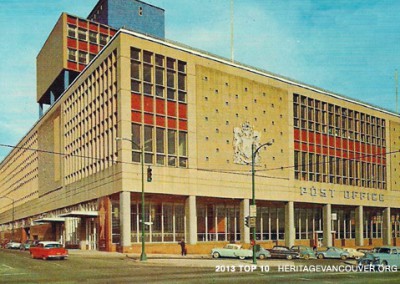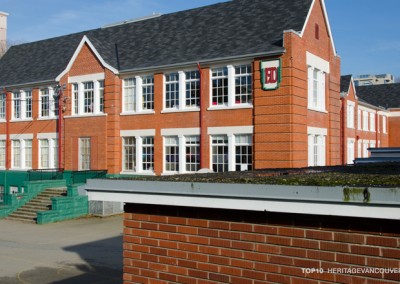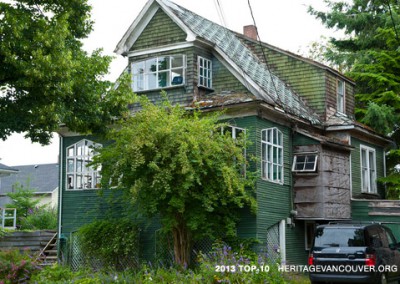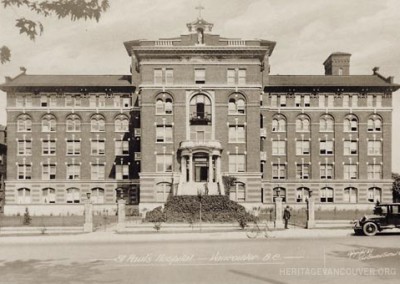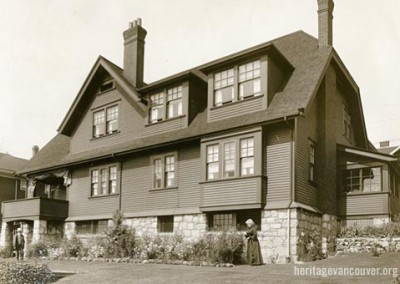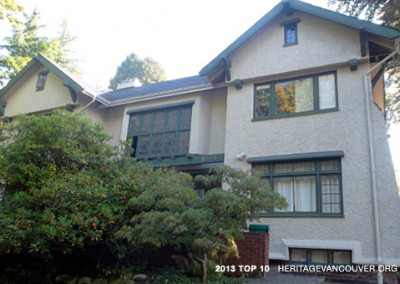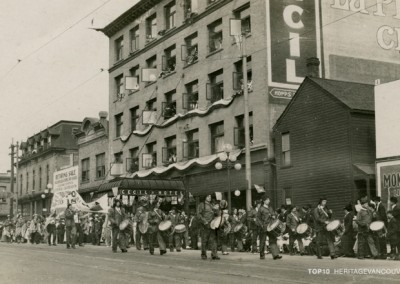1489 Hastings Street East
The Waldorf Hotel was the centre of a blitz of social media this year, as news of its sale and the loss of its cultural programming hit a raw nerve in Vancouver’s cultural and artistic communities. Was this the beginning of the end for East Vancouver’s new-found status as the happening place to be? Would we lose our last, beloved historic palace of Polynesian pop culture? Even the City jumped on this issue with a temporary freeze on demolition.
Despite this flurry of interest, the Waldorf Hotel is not recognized on the Heritage Register, lacks heritage protection of either its interior or exterior, and its fate remains unknown.
Threat
What is the threat to The Waldorf?
In fact there is a dual threat, with the potential loss of a heritage building but also the cultural activities that the Waldorf has fostered, especially in the last few years, when it was rejuvenated as a hip social and creative venue.
In January, 2013, the owner of the Waldorf entered into an agreement for sale with a developer, due to close in October, 2013; the tenant, Waldorf Productions moved out of the building; and currently only the restaurant remains open. The “Tiki Room” is the sole room that remains largely intact. The others have been compromised and a number of tiki artifacts are due to be removed by the vendor after the sale in October.
For many arts supporters, this was “the last straw” in a seemingly unbroken list of deaths of Vancouver creative organizations. The most recent fatalities include: the closing and imminent destruction, for the inevitable condos, of the 1950 Ridge movie theatre; the suspension after 12 years of the summertime MusicFest Vancouver; the closing of the Vancouver Playhouse Theatre Company in 2012; the demolition of the historic Pantages Theatre on East Hastings in 2011; and before that, the live music venues Richard’s on Richards and the Starfish Room were also razed for condos.
Virtually all the local media and many national publications have featured articles commenting on the unprecedented, unacceptable and accelerating pace of destruction of cultural venues in Vancouver. One example of the commentary is a mid-January article by Kerry Gold in the B.C. Section of the Globe and Mail entitled: “The Catch-22 of Culture: the hubs that mark creative communities breed popular affection – and the attention of developers“. Similarly, The Georgia Straight Real Estate column on January 17, 2013 bears the title: “Arts venues under siege“.
The unique Waldorf Hotel is located in an Industrial Zone, but the site is clearly being targeted for housing. To buy time, City Council instituted a 120-day freeze, and directed staff to report back by mid-May on the heritage significance of The Waldorf. This is only one of a myriad of significant heritage buildings that is not on the City of Vancouver Heritage Register.
The original Heritage Inventory (now the Register) was approved in 1986 and despite many promises has still not been updated. Had the Register been updated, the Waldorf Hotel and its unique interior spaces would have been listed and thereby offered a degree of protection.
Instead, whenever heritage buildings like this are threatened, the public and private sectors waste valuable time in last-minute campaigns, first to determine the importance of the “heritage resource” and then to determine if it can be saved and how this can be achieved.
Significance
Why is The Waldorf significant?
The Waldorf Hotel is significant as both a heritage site and a cultural venue. Since opening in 1948, it has remained in operation as a hotel and a place of entertainment, celebration and creative culture in East Vancouver. The Waldorf dates from the postwar era when air travel was not as common as it is today, and people “escaped” to exotic places by attending venues styled with exotic décor and entertainment.
The Waldorf contains the oldest surviving Polynesian “Tiki” Rooms in Western Canada. The superb quality of the interior work is flamboyant and quirky, yet the overall effect is sublimely orchestrated. For many years after the Second World War, there was a craze for all things Hawaiian and Polynesian. The reasons included the acceptance of Hawaii as a state, the return of soldiers who had spent time in the region and popular musicals and movies like “South Pacific”. Those who could afford it began to travel to Hawaii, while others were happy to spend some of their increased leisure time visiting “Tiki” lounges and Hawaiian-themed restaurants.
The Waldorf Hotel was constructed in 1947-48 by hotelier Bob Mills and designed by Mercer & Mercer Architects in a streamline Moderne Style. The hotel opened with 25 hotel rooms and a large ground floor beer parlour.
In 1954-55 the same architects modified and expanded the building to accommodate the now famous “Tahitian Cocktail Lounge” (Tiki Lounge), an additional lounge, a descending spiral staircase, a restaurant and six more hotel rooms. The Tiki Lounge features a midnight blue half-domed ceiling reflected in a wall of mirrors to complete the illusion of a night sky, with inset twinkling star-lights. The effect is heightened by fake palm trees, bamboo matting, floral carpets, and a series of superb black velvet paintings, by Edgar Leeteg (1904-1953) the artist who invented the genre. The same attention to detail was lavished on the Polynesian décor in the Cabaret Room. Exotic Polynesian scenes, in the murals created by the well-known artist Peter Hopkinson, are framed by a colonnade of bamboo-shaped columns and bamboo-covered walls.
The exterior of The Waldorf is also significant. The streamline Moderne style was one of the types of modern design popular during the postwar construction boom in Vancouver. In the words of the famous planner and UBC professor Peter Oberlander, modernist architecture represented “…a new conception of architecture satisfying the spiritual, intellectual, and material needs of present day life.” There are few surviving commercial buildings in the Moderne style, however, since many were built downtown and have been demolished to make way for larger new structures. In 2010, Scott Cohen Architect undertook a sensitive restoration of the Waldorf. This included stripping down the exterior to restore the original poured concrete walls, the streamlined architectural details and the early modern wood and glass curtain walls at the entrance. In the interior, compatible new materials were chosen to avoid a jarring distinction between new and old elements.
Culturally, The Waldorf has been a focus for the community since 1948. From 2010 until the end of its contract in January 2013, Waldorf Productions created a unique hub for arts and culture in the building. Many of the city’s most creative visual and performing artists congregated there to produce new and stimulating events, which attracted wide support.
There was an outpouring of anger and frustration when Waldorf Productions announced it would end its tenancy and the owner announced plans to sell the property to the development firm, Solterra Development Corporation (entered into an agreement for sale closing in October, 2013.) This prompted an unprecedented social media campaign, which very quickly led to City Council’s decision to impose the 120-day freeze in order to look for possible solutions to the loss of this resource.
Position
Heritage Vancouver’s position
The uncertain fate of the unique interior spaces as well as the Moderne exterior of The Waldorf is further proof that the Heritage Register must be updated. We urge City Council to approve adequate funds in next year’s (2014) budget so that the Planning Department can initiate this work.
We support the City’s initiative in properly assessing the Waldorf by commissioning a “Statement of Significance” (SOS). We hope that the City will follow through on the implications that flow from this heritage assessment.
Given the accelerating rate of loss of vital community cultural spaces, Heritage Vancouver recommends that the City of Vancouver:
- Work with private and public partners to conserve vital cultural spaces such as the Waldorf, performance spaces (for live music, theatre and dance), rehearsal spaces to support these live performances, and historic movie theatres.
- Consider a proposal to identify the cultural assets that the city determines to be important and vulnerable. This is similar to the city’s mapping of affordable existing rental housing areas, which were included in a “rate-of-change” bylaw. This makes it clear what the city expects from any property owner who proposes changes or redevelopment on such a property.
Actions
Updates
Photo gallery of the Waldorf from our 2011 Tiki themed event


